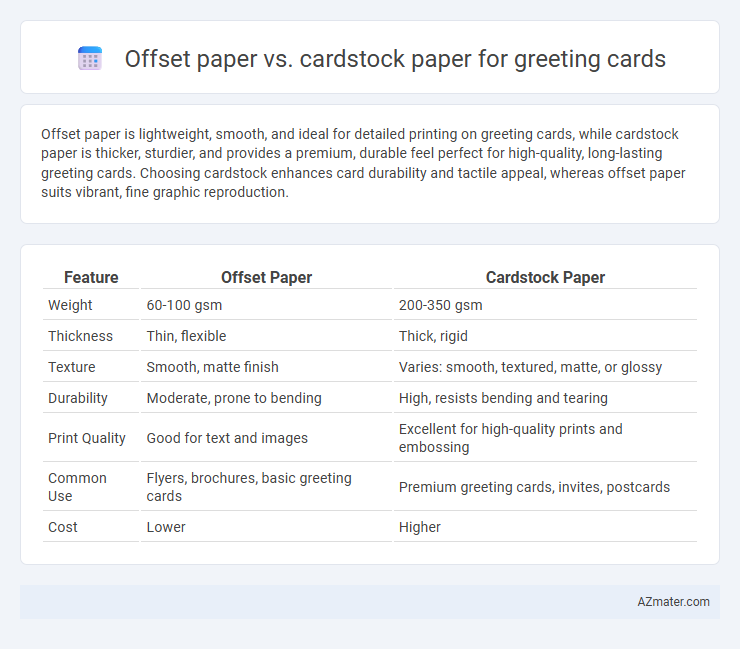Offset paper is lightweight, smooth, and ideal for detailed printing on greeting cards, while cardstock paper is thicker, sturdier, and provides a premium, durable feel perfect for high-quality, long-lasting greeting cards. Choosing cardstock enhances card durability and tactile appeal, whereas offset paper suits vibrant, fine graphic reproduction.
Table of Comparison
| Feature | Offset Paper | Cardstock Paper |
|---|---|---|
| Weight | 60-100 gsm | 200-350 gsm |
| Thickness | Thin, flexible | Thick, rigid |
| Texture | Smooth, matte finish | Varies: smooth, textured, matte, or glossy |
| Durability | Moderate, prone to bending | High, resists bending and tearing |
| Print Quality | Good for text and images | Excellent for high-quality prints and embossing |
| Common Use | Flyers, brochures, basic greeting cards | Premium greeting cards, invites, postcards |
| Cost | Lower | Higher |
Introduction: Choosing the Right Paper for Greeting Cards
Offset paper offers a smooth, matte surface ideal for detailed printing and vibrant colors, making it a popular choice for standard greeting cards. Cardstock paper, thicker and more durable, provides a premium feel and excellent sturdiness that enhances the overall presentation and longevity of greeting cards. Selecting between offset paper and cardstock depends on the desired texture, durability, and visual impact for the final greeting card product.
What is Offset Paper?
Offset paper, commonly used in commercial printing, is a lightweight, uncoated paper known for its smooth finish and excellent print clarity, making it ideal for detailed designs on greeting cards. This type of paper absorbs ink well, providing vibrant colors without smudging, yet it lacks the rigidity of cardstock, resulting in a more flexible and thinner card. Offset paper's cost-effectiveness and ease of printing suit mass-produced greeting cards where crisp images and text are essential but a sturdy feel is less critical.
What is Cardstock Paper?
Cardstock paper is a thick, durable material often used for greeting cards due to its sturdiness and ability to hold vibrant colors and sharp details. It typically ranges from 65 lb to 110 lb in weight, providing a solid feel compared to the thinner offset paper commonly used for flyers and brochures. Its textured surface and rigidity make cardstock ideal for creating professional-looking, high-quality greeting cards that withstand handling better than offset paper.
Thickness and Durability Comparison
Offset paper typically ranges from 70 to 120 gsm, offering moderate thickness suitable for standard greeting cards, while cardstock paper is significantly thicker, usually between 200 and 350 gsm, providing enhanced durability and a premium feel. The higher density of cardstock ensures resistance to bending, tearing, and general wear, making it ideal for greeting cards that require sturdiness and a substantial hand feel. Offset paper is more flexible and lightweight but less durable, which may affect the longevity and perceived quality of greeting cards compared to the robust nature of cardstock.
Print Quality: Offset vs Cardstock
Offset paper provides a smooth surface and consistent texture that enhances detailed printing, making it ideal for high-resolution images and vibrant colors on greeting cards. Cardstock paper offers a thicker, more durable option with a slightly textured finish that can add tactile appeal but may absorb ink differently, affecting sharpness and color vibrancy. For premium print quality, offset paper typically delivers finer detail and more vivid results, while cardstock provides a robust feel with a potential trade-off in image precision.
Texture and Finish Differences
Offset paper offers a smooth, matte texture ideal for crisp, detailed printing, often used for lightweight greeting cards that require easy folding. Cardstock paper features a thicker, sturdier feel with a textured or glossy finish, providing durability and a premium tactile experience for high-quality greeting cards. The finish variations in cardstock, such as linen or velvet textures, enhance visual appeal and create a more luxurious impression compared to the flat finish of offset paper.
Cost Considerations for Offset and Cardstock
Offset paper for greeting cards offers a lower cost per sheet compared to cardstock, making it ideal for large volume printing where budget efficiency is critical. Cardstock paper, while more expensive due to its thickness and durability, provides a premium feel and enhanced sturdiness that justifies the additional expense for special or high-end greeting cards. Businesses must weigh the cost differences against the desired quality and target market, as offset paper minimizes upfront costs but cardstock elevates perceived value.
Suitability for Different Greeting Card Styles
Offset paper, known for its smooth texture and lightweight properties, suits intricate greeting card designs requiring detailed prints and vibrant colors, ideal for elegant or minimalist styles. Cardstock paper offers sturdiness and thickness, making it perfect for pop-up cards, layered designs, or cards needing durability and a premium feel. Choosing between offset paper and cardstock depends on the desired card style, with offset paper excelling in fine print quality and cardstock providing structural support for elaborate and tactile elements.
Environmental Impact: Offset vs Cardstock
Offset paper typically has a lower environmental impact due to its lighter weight and higher recyclability compared to heavyweight cardstock, which requires more raw materials and energy for production. Cardstock often uses thicker fibers and coatings, resulting in increased resource consumption and more challenging recycling processes. Choosing offset paper for greeting cards can reduce carbon footprint and waste while maintaining print quality, making it a more eco-friendly option.
Conclusion: Which Paper is Best for Greeting Cards?
Cardstock paper is best for greeting cards due to its thicker, more durable texture, providing a premium feel and better support for intricate designs and embellishments. Offset paper, while smooth and cost-effective, lacks the sturdiness and opacity required for high-quality greeting cards. Choosing cardstock ensures a professional appearance and longevity, making it ideal for both personal and commercial greeting card projects.

Infographic: Offset paper vs Cardstock paper for Greeting card
 azmater.com
azmater.com